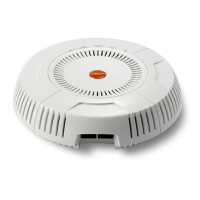Wireless Access Point
350 Configuring the Wireless AP
Procedure for Configuring Global 802.11ac IAP Settings
1. 802.11ac Mode: Select Enabled to allow the AP to operate in 802.11ac
mode. If you select Disabled, then 802.11ac operation is disabled on the
AP.
2. 80 MHz Guard interval: This is the length of the interval between
transmission of symbols (the smallest unit of data transfer) when you are
using 80MHz bonded channels. (See “80 MHz and 160 MHz Channel
Widths (Bonding)” on page 48.) Select Short to increase the data
transmission rate by decreasing wait intervals in signal transmission.
Select Long to use the standard interval. The default is Short.
3. Max MCS: Select the highest Modulation and Coding Scheme level that
may be used with 1 or 2 Spatial Streams. For models with 3x3 radios,
there is also a setting for 3 Spatial Streams. This setting may be used to
limit the highest level of modulation to 64-QAM, or allow 256-QAM with
its higher data rate. It also determines the coding scheme used for error
correction. Higher MCS levels allocate fewer bits to error correction, and
thus a higher proportion is used for data transfer. The default Max MCS
value is MCS9.
The higher the MCS values, the higher the data rate, as shown in 802.11ac
Supported Rates, below. Higher MCS levels require higher signal-to-
noise ratios (i.e., a less noisy environment) and shorter transmission
distances. See “Higher Precision in the Physical Layer” on page 47.
The maximum number of separate data streams that may be transmitted
by the antennas of each IAP is determined by whether the AP has 2x2 or
3x3 radios. For a device that has 2x2 radios, such as the XR-620, the
settings for three spatial streams are not shown. See “Up to Eight
Simultaneous Data Streams — Spatial Multiplexing” on page 44.
4. 802.11ac Supported Rates: This list shows the optimum data rates that
can be expected, based on the number of spatial streams that a station can
handle, and on your settings for Max MCS, Guard Interval, and the use of
bonded channels, up to 80MHz wide.

